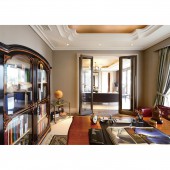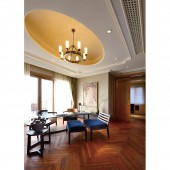Lanting Pavilion Show Villa by David Chang |
Home > Winners > #63353 |
 |
|
||||
| DESIGN DETAILS | |||||
| DESIGN NAME: Lanting Pavilion PRIMARY FUNCTION: Show Villa INSPIRATION: Jiangsu is famous for its silk and embroidery since ancient times. The design was inspired by the Suzhou embroidery. Suzhou embroidery has a history of over 2000 years. It is recorded that as early as in the spring and autumn warriors Period , 771 to 476 BC, Suzhou embroidery was already applied on apparel in the state of Wu. Nowadays, it has already become a treasure in the Chinese handicrafts with the delicacy in layout and exquisite liveliness in techniques. UNIQUE PROPERTIES / PROJECT DESCRIPTION: The project is located on the east bank of Yangcheng Lake. The property is built in the traditional Suzhou garden style to highlight the beauty of local culture and the harmony in the landscape and building are refreshing to mind and body. OPERATION / FLOW / INTERACTION: The essence of Kun opera is embodied in the wriggling and elegant space structure. The delicate color and atmosphere, the fine texture, concise outline with gentle and lingering rhythms are in harmony with the picturesque sceneries outside. PROJECT DURATION AND LOCATION: Commencement of design: May 2011 Completion: March 2012 Location: Kunshan, Jiangsu, China FITS BEST INTO CATEGORY: Interior Space and Exhibition Design |
PRODUCTION / REALIZATION TECHNOLOGY: In the details, Chinese elements such as the paper-cut for windows, plum blossom petal shape, traditional patterns for clothes, classical window framework are captured and translated with metal, leather, mirror, wood and other types of materials. Handrails of stairway refer to the shape of sword in the Wu Yue culture. Brass handrails are covered with leather in the same color to have a warm touch, and to well combine the aesthetics and functionality. SPECIFICATIONS / TECHNICAL PROPERTIES: Total area: 315 square meters Height: highest 2.95m, lowest 2.7m TAGS: Luxury, Residence, Interior Design, Classical RESEARCH ABSTRACT: Because the property is neighboring the traditional South China gardens, in order to make the interior match with the exterior views, at the early stage, the designers went to Suzhou Museum and Lion Grove Garden to search for inspiration. Eventually the beauty of the traditional architecture south of the Yangtze River was reinterpreted by the selection of local decorative materials, stones, brick carving, wall paper and silk that could represent the charm of the southern customs in the way of traditional Chinese ink and wash paintings. CHALLENGE: The dining area is expanded to the axis of symmetry, and the column was rendered into an archway so that the dining space was enlarged and placed closer to the lake, creating more communication with and involvement into the nature. The kitchen was expanded into a U-shape layout to maximize functionality. Considering the holistic plan, a foyer was added to the staircase as a place for a respite. ADDED DATE: 2018-01-23 10:46:20 TEAM MEMBERS (3) : Chief Design Director : David Chang, Designer: Elva Ma and Designer: Allen Hu IMAGE CREDITS: Clyde Chang PATENTS/COPYRIGHTS: Copyrights belong to David Chang Design Associates International, 2018 |
||||
| Visit the following page to learn more: http://www.dcida.com | |||||
| AWARD DETAILS | |
 |
Lanting Pavilion Show Villa by David Chang is Winner in Interior Space and Exhibition Design Category, 2017 - 2018.· Read the interview with designer David Chang for design Lanting Pavilion here.· Press Members: Login or Register to request an exclusive interview with David Chang. · Click here to register inorder to view the profile and other works by David Chang. |
| SOCIAL |
| + Add to Likes / Favorites | Send to My Email | Comment | Testimonials | View Press-Release | Press Kit |
Did you like David Chang's Interior Design?
You will most likely enjoy other award winning interior design as well.
Click here to view more Award Winning Interior Design.








